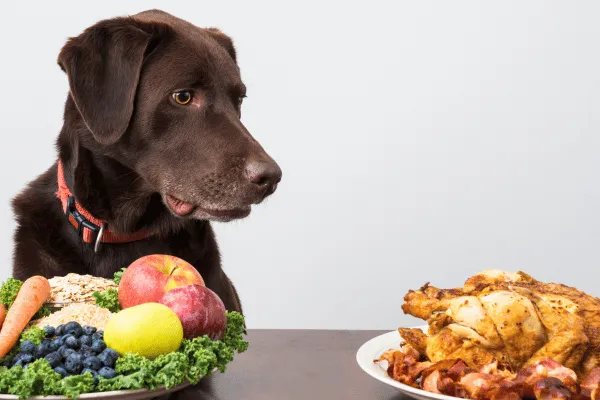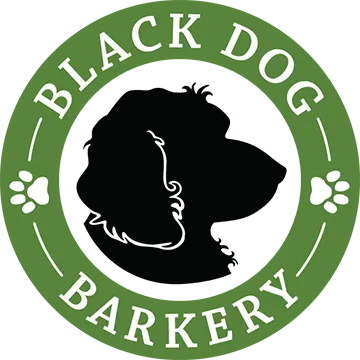Black Dog Blog
Your go-to source for holistic pet care tips.
Black Dog Blog
Welcome to the Black Dog Blog! Your go-to source for holistic pet care.

Why Rotating Your Dog’s Protein Source Is Good for Their Health
If your dog eats the same meal every day, every week, every year—well, let’s just say their taste buds (and their body) might be craving a little change. Just like we wouldn’t thrive eating the same meal daily, dogs benefit from variety in their diet too—especially when it comes to protein sources.
But what exactly does “rotating proteins” mean? And how do you do it without upsetting your dog’s stomach?
Let’s dig into the benefits of protein rotation, how often to do it, and the best way to switch foods without causing diarrhea or digestive drama—plus some helpful tips for pet parents right here in Bristol.
Why Rotating Your Dog’s Protein Source Is Good for Their Health
🐾 Should You Switch Your Dog's Food Often?
🦴 Benefits of Switching Your Dog’s Protein Source
1. Prevents Nutrient Deficiencies
2. Reduces Risk of Food Allergies and Sensitivities
3. Improves Digestive Resilience
💩 How to Switch Dog Food Without Diarrhea
🐕🦺 Best Proteins to Rotate (and What They Offer)
🥩 Want Variety Without Switching Entire Meals? Try Food Toppers
Why food toppers are a smart choice:
🐾 Should You Switch Your Dog's Food Often?

Short answer: yes, but not too often. Rotating your dog’s food protein source every few weeks to months is a healthy and recommended habit.
The goal isn’t to overhaul your dog’s diet every week, but to offer a steady rhythm of variety. Many holistic vets suggest rotating between two to four different protein sources throughout the year.
Think of it like cross-training for the digestive system: a bit of exposure to different foods keeps things sharp and flexible.
🦴 Benefits of Switching Your Dog’s Protein Source

So why make the switch in the first place? There’s more to it than just keeping dinner interesting. Here’s what rotating protein sources can actually do for your dog’s health:
1. Prevents Nutrient Deficiencies
Each protein offers a unique amino acid profile and nutrient balance:
Beef is high in zinc and iron—great for immune health and red blood cell production.
Fish (like salmon) brings omega-3s for brain, skin, and coat health.
Lamb is richer in fat and iron, perfect for underweight or highly active dogs.
By rotating proteins, you’re giving your dog a more complete nutrient profile over time—no single protein offers it all.
2. Reduces Risk of Food Allergies and Sensitivities
Feeding the same protein over and over can lead to overexposure—and eventually, sensitivities. Alternating proteins helps minimize that risk by spreading the exposure across multiple sources.
3. Improves Digestive Resilience
Dogs that are used to variety tend to handle changes better so the earlier you start with your dog, the better. Rotational feeding trains their gut to adapt, which can reduce the chances of stomach upset over time.
4. Prevents Food Boredom
Rotating proteins reintroduces excitement into your dog’s routine. New smells, new textures—it all makes mealtime more engaging (and more delicious).
5. Supports Overall Wellness
By ensuring your dog gets a wider range of nutrients while avoiding dietary fatigue, you’re supporting not only digestive and immune health, but long-term wellness too.
💩 How to Switch Dog Food Without Diarrhea

We get it—this is the part that makes a lot of dog parents nervous. A sudden switch can upset your dog’s tummy. That’s why we recommend a gradual transition.
The 5-7 Day Transition Rule:
Make any protein rotation gradually by blending the new food with the old over several days:
Day 1–2: 75% old food, 25% new food
Day 3–4: 50/50 mix
Day 5–6: 25% old food, 75% new food
Day 7: 100% new food
Pro Tip for Bristol Pet Parents: Adding a spoonful of plain pumpkin or stopping by and grabbing a little goat’s milk during the transition can help support digestive comfort. during the transition can help support digestive comfort.
But... Every Dog is Different
Some dogs handle rotation like champs—others need a little more TLC. It’s important to watch your dog closely during each transition. If you notice digestive changes (like soft stool, gassiness, or disinterest in food), it may be a sign to extend the transition period or stay on each protein longer before switching again.
There’s no one-size-fits-all rotation schedule—your dog’s unique needs should always lead the way. What matters most is that the transition is gentle, the proteins are high quality, and your pup is thriving.
🐕🦺 Best Proteins to Rotate (and What They Offer)

Here’s a snapshot of popular proteins and why you might consider each one:
Chicken: Lean, digestible, high in B vitamins
Beef: Iron and zinc-rich, supports energy and immunity
Salmon: Rich in omega-3s, promotes brain and coat health
Turkey: Lean and hypoallergenic, gentle on digestion
Lamb: Higher fat and iron, great for active or underweight dogs
Duck: Flavorful and novel, ideal for picky eaters or dogs with allergies
Venison: Lean and unique, great for sensitive or allergic dogs
🥩 Want Variety Without Switching Entire Meals? Try Food Toppers

Not ready to switch your dog’s full food just yet? Food toppers are a great stepping stone. They’re a simple, low-risk way to add variety, flavor, and nutrition to your dog’s existing diet—without a full transition.
Toppers can include:
Lightly cooked or raw meat proteins (like lamb, duck, venison)
Freeze-dried raw bits or crumbles
Gently cooked stew-style mixers
Omega-3 rich options like sardines or salmon oil
Gut-healthy additions like pumpkin, goat’s milk, or bone broth
Why food toppers are a smart choice:
Introduce new proteins gradually
They let your dog experience new protein sources in small amounts before fully rotating.Boost nutrition
High-quality toppers often add nutrients that kibble alone may lack—like moisture, omega-3s, or live probiotics.Picky dog? No problem
Toppers can reignite interest in food for dogs who’ve grown bored or disinterested.
Many of the brands we carry at Black Dog Barkery offer excellent topper options, whether you're feeding raw, dry, or gently cooked. You can explore them on our Food Partners page—they’re canine nutritionist-approved and designed to mix and match easily with your dog's main diet.
Pro Tip: Start with small amounts (1–2 tbsp) mixed into meals and increase gradually. You’ll be adding flavor, function, and fun—all in one scoop.
🧠 What About Younger Dogs?

Protein rotation is arguably more valuable for younger dogs than it is for seniors or allergy-prone pups.
Builds gut adaptability early on
Helps prevent picky eating
May reduce allergy risk later in life
If your pup is still growing, be sure to use formulas designed for their life stage—and always transition slowly and intentionally.
🐶 Final Thoughts: Variety Feeds Vitality
For dog lovers here in Bristol and beyond, rotating proteins isn’t just a trend—it’s a wellness strategy. It supports digestion, immunity, mealtime engagement, and nutritional balance. But the most important piece? Paying attention to your individual dog. Some dogs thrive on frequent changes, while others do best with a slower pace. Watch their cues, and adjust your rotation schedule as needed.
When done thoughtfully, rotating your dog’s protein source is one of the simplest ways to support their lifelong health.
Need help getting started? Reach out or stop by—we’re always happy to help you build a healthy rotation plan that works for your dog and your lifestyle.
FAQs
Q: Can I rotate between dry, wet, and raw food formats too?
Yes! Many pet parents rotate not just proteins, but food types. Just make sure to introduce new formats gradually and consult your vet if switching between raw and kibble.
Q: What are signs that a protein doesn’t agree with my dog?
Look for loose stool, vomiting, itchiness, or low energy. If those symptoms appear consistently with a particular protein, take a break and consult your vet.
Q: Can I rotate protein if my dog has a sensitive stomach?
Yes—just go slow. Start with easily digestible proteins (like turkey or fish) and use gut-soothing add-ons like bone broth or plain pumpkin.

Why Rotating Your Dog’s Protein Source Is Good for Their Health
If your dog eats the same meal every day, every week, every year—well, let’s just say their taste buds (and their body) might be craving a little change. Just like we wouldn’t thrive eating the same meal daily, dogs benefit from variety in their diet too—especially when it comes to protein sources.
But what exactly does “rotating proteins” mean? And how do you do it without upsetting your dog’s stomach?
Let’s dig into the benefits of protein rotation, how often to do it, and the best way to switch foods without causing diarrhea or digestive drama—plus some helpful tips for pet parents right here in Bristol.
Why Rotating Your Dog’s Protein Source Is Good for Their Health
🐾 Should You Switch Your Dog's Food Often?
🦴 Benefits of Switching Your Dog’s Protein Source
1. Prevents Nutrient Deficiencies
2. Reduces Risk of Food Allergies and Sensitivities
3. Improves Digestive Resilience
💩 How to Switch Dog Food Without Diarrhea
🐕🦺 Best Proteins to Rotate (and What They Offer)
🥩 Want Variety Without Switching Entire Meals? Try Food Toppers
Why food toppers are a smart choice:
🐾 Should You Switch Your Dog's Food Often?

Short answer: yes, but not too often. Rotating your dog’s food protein source every few weeks to months is a healthy and recommended habit.
The goal isn’t to overhaul your dog’s diet every week, but to offer a steady rhythm of variety. Many holistic vets suggest rotating between two to four different protein sources throughout the year.
Think of it like cross-training for the digestive system: a bit of exposure to different foods keeps things sharp and flexible.
🦴 Benefits of Switching Your Dog’s Protein Source

So why make the switch in the first place? There’s more to it than just keeping dinner interesting. Here’s what rotating protein sources can actually do for your dog’s health:
1. Prevents Nutrient Deficiencies
Each protein offers a unique amino acid profile and nutrient balance:
Beef is high in zinc and iron—great for immune health and red blood cell production.
Fish (like salmon) brings omega-3s for brain, skin, and coat health.
Lamb is richer in fat and iron, perfect for underweight or highly active dogs.
By rotating proteins, you’re giving your dog a more complete nutrient profile over time—no single protein offers it all.
2. Reduces Risk of Food Allergies and Sensitivities
Feeding the same protein over and over can lead to overexposure—and eventually, sensitivities. Alternating proteins helps minimize that risk by spreading the exposure across multiple sources.
3. Improves Digestive Resilience
Dogs that are used to variety tend to handle changes better so the earlier you start with your dog, the better. Rotational feeding trains their gut to adapt, which can reduce the chances of stomach upset over time.
4. Prevents Food Boredom
Rotating proteins reintroduces excitement into your dog’s routine. New smells, new textures—it all makes mealtime more engaging (and more delicious).
5. Supports Overall Wellness
By ensuring your dog gets a wider range of nutrients while avoiding dietary fatigue, you’re supporting not only digestive and immune health, but long-term wellness too.
💩 How to Switch Dog Food Without Diarrhea

We get it—this is the part that makes a lot of dog parents nervous. A sudden switch can upset your dog’s tummy. That’s why we recommend a gradual transition.
The 5-7 Day Transition Rule:
Make any protein rotation gradually by blending the new food with the old over several days:
Day 1–2: 75% old food, 25% new food
Day 3–4: 50/50 mix
Day 5–6: 25% old food, 75% new food
Day 7: 100% new food
Pro Tip for Bristol Pet Parents: Adding a spoonful of plain pumpkin or stopping by and grabbing a little goat’s milk during the transition can help support digestive comfort. during the transition can help support digestive comfort.
But... Every Dog is Different
Some dogs handle rotation like champs—others need a little more TLC. It’s important to watch your dog closely during each transition. If you notice digestive changes (like soft stool, gassiness, or disinterest in food), it may be a sign to extend the transition period or stay on each protein longer before switching again.
There’s no one-size-fits-all rotation schedule—your dog’s unique needs should always lead the way. What matters most is that the transition is gentle, the proteins are high quality, and your pup is thriving.
🐕🦺 Best Proteins to Rotate (and What They Offer)

Here’s a snapshot of popular proteins and why you might consider each one:
Chicken: Lean, digestible, high in B vitamins
Beef: Iron and zinc-rich, supports energy and immunity
Salmon: Rich in omega-3s, promotes brain and coat health
Turkey: Lean and hypoallergenic, gentle on digestion
Lamb: Higher fat and iron, great for active or underweight dogs
Duck: Flavorful and novel, ideal for picky eaters or dogs with allergies
Venison: Lean and unique, great for sensitive or allergic dogs
🥩 Want Variety Without Switching Entire Meals? Try Food Toppers

Not ready to switch your dog’s full food just yet? Food toppers are a great stepping stone. They’re a simple, low-risk way to add variety, flavor, and nutrition to your dog’s existing diet—without a full transition.
Toppers can include:
Lightly cooked or raw meat proteins (like lamb, duck, venison)
Freeze-dried raw bits or crumbles
Gently cooked stew-style mixers
Omega-3 rich options like sardines or salmon oil
Gut-healthy additions like pumpkin, goat’s milk, or bone broth
Why food toppers are a smart choice:
Introduce new proteins gradually
They let your dog experience new protein sources in small amounts before fully rotating.Boost nutrition
High-quality toppers often add nutrients that kibble alone may lack—like moisture, omega-3s, or live probiotics.Picky dog? No problem
Toppers can reignite interest in food for dogs who’ve grown bored or disinterested.
Many of the brands we carry at Black Dog Barkery offer excellent topper options, whether you're feeding raw, dry, or gently cooked. You can explore them on our Food Partners page—they’re canine nutritionist-approved and designed to mix and match easily with your dog's main diet.
Pro Tip: Start with small amounts (1–2 tbsp) mixed into meals and increase gradually. You’ll be adding flavor, function, and fun—all in one scoop.
🧠 What About Younger Dogs?

Protein rotation is arguably more valuable for younger dogs than it is for seniors or allergy-prone pups.
Builds gut adaptability early on
Helps prevent picky eating
May reduce allergy risk later in life
If your pup is still growing, be sure to use formulas designed for their life stage—and always transition slowly and intentionally.
🐶 Final Thoughts: Variety Feeds Vitality
For dog lovers here in Bristol and beyond, rotating proteins isn’t just a trend—it’s a wellness strategy. It supports digestion, immunity, mealtime engagement, and nutritional balance. But the most important piece? Paying attention to your individual dog. Some dogs thrive on frequent changes, while others do best with a slower pace. Watch their cues, and adjust your rotation schedule as needed.
When done thoughtfully, rotating your dog’s protein source is one of the simplest ways to support their lifelong health.
Need help getting started? Reach out or stop by—we’re always happy to help you build a healthy rotation plan that works for your dog and your lifestyle.
FAQs
Q: Can I rotate between dry, wet, and raw food formats too?
Yes! Many pet parents rotate not just proteins, but food types. Just make sure to introduce new formats gradually and consult your vet if switching between raw and kibble.
Q: What are signs that a protein doesn’t agree with my dog?
Look for loose stool, vomiting, itchiness, or low energy. If those symptoms appear consistently with a particular protein, take a break and consult your vet.
Q: Can I rotate protein if my dog has a sensitive stomach?
Yes—just go slow. Start with easily digestible proteins (like turkey or fish) and use gut-soothing add-ons like bone broth or plain pumpkin.

Copyright Black Dog Barkery 2025 | Terms | Privacy Policy
Website built by Passive Profits Group
Copyright Black Dog Barkery 2025 | Terms | Privacy Policy


